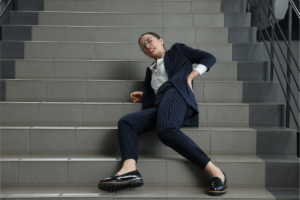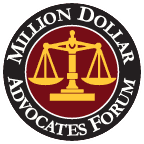The eight most common causes of slips and falls might surprise some people, but they highlight just how easy it is to prevent these accidents with proper precautions.

Each year, approximately one million people visit the emergency room due to slip and fall accidents. Anyone can be injured to a slip and fall. Someone who is perfectly healthy and mobile may have a slip and fall accident and suddenly face years of physical pain, mental anguish, and financial difficulties. The consequences of these accidents can range from minor bumps and bruises to severe injuries such as broken bones, and in some cases, they can even be fatal. However, most of these incidents are preventable.
Eight Common Causes of Slip and Fall Accidents:
- Wet and Slippery Surfaces Wet surfaces from spills, freshly mopped floors, or rain and snow can easily lead to slip and fall accidents. Supermarkets and bathrooms are particularly prone to these hazards. Quick clean-up and visible warning signs are essential to prevent these incidents.
- Cluttered Floors Objects left in walkways, such as loose cables and debris, can be major tripping hazards. Poor housekeeping in places like offices and retail spaces increases the risk. Keeping floors clear and organized is crucial to avoid these accidents.
- Uneven Walking Surfaces Uneven floors, potholes, and damaged sidewalks can cause someone to lose their balance and fall. Regular maintenance of both indoor and outdoor walkways is essential to prevent these dangers.
- Recently Cleaned or Waxed Floors Freshly cleaned or waxed floors can be unexpectedly slippery. Certain cleaning products leave a slick residue that heightens the risk of falling. Using warning signs and choosing products that reduce slipperiness can help prevent accidents.
- Weather Conditions Ice, snow, and rain significantly increase the risk of outdoor slip and fall accidents. Property owners should take proactive steps, like salting walkways in winter and ensuring proper drainage, to mitigate these risks.
- Inadequate Lighting Poor lighting can obscure potential tripping hazards, leading to falls. Ensuring proper illumination in areas like parking lots and stairwells by installing sufficient lighting and promptly replacing burnt-out bulbs can prevent accidents.
- Improper Footwear Wearing shoes without proper grip or those unsuitable for certain conditions can increase the likelihood of a fall. Choosing footwear with good traction and appropriate for the activity can help maintain safety.
- Lack of Handrails and Guardrails Inadequate or missing handrails and guardrails in staircases and elevated platforms can lead to falls. These features provide essential stability and support, particularly in areas where balance is critical. Ensuring these safety measures are installed and secure is vital for fall prevention.
How to Prevent Slip and Fall Accidents
Property owners can take several measures to help prevent slip and fall accidents, ensuring the safety of visitors:
- Posting Warnings:
- Use signs like “Caution: Wet Floor” or “Slippery, Watch Step” to alert pedestrians of potential hazards due to cleaning or waxing activities.
- Fixing Defects:
- Address any known issues such as cracks or uneven surfaces promptly, or provide clear warnings to pedestrians until repairs can be made.
- Cleaning Spills:
- Clean up spills on walking surfaces immediately to prevent slipping hazards.
- Routine Inspections:
- Conduct regular inspections, especially during times of high occupancy, to identify and mitigate potential hazards.
- Addressing Weather Conditions:
- Shovel snow and apply salt to icy areas to ensure safe passage for pedestrians.
- Proper Lighting:
- Ensure all areas are well-lit to prevent accidents due to poor visibility.
- Educating Staff and Household Members:
- Train employees and household members to recognize and address potential hazards and to warn visitors when necessary.
Visitors can also take steps to reduce their risk of slip and fall accidents:
- Limiting Distractions:
- Stay focused on your surroundings to avoid potential hazards.
- Wearing Appropriate Attire:
- Choose footwear that is safe and suitable for the current conditions.
- Slowing Down:
- Walk at a safe pace, especially in areas that may pose a risk.
- Adhering to Warnings:
- Pay attention to and follow any posted safety signs and warnings.
Even with all these precautions, slip and fall accidents can still occur. If you are involved in such an accident, whether as the injured party or the property owner, seeking legal representation with us at Howard Injury Law immediately is crucial. One of our experienced slip and fall lawyer Las Vegas can guide you through the complex and time-sensitive processes of legal negotiations and proceedings.
What Compensation Can I Receive for My Slip and Fall Injuries?
If you can demonstrate that a property owner’s negligence caused your slip and fall accident, you may be entitled to various forms of compensation for your injuries. These can include:
- Medical Expenses: Coverage for all medical bills related to the injury, including emergency room visits, hospital stays, surgeries, and follow-up treatments.
- Rehabilitation Costs: Expenses for physical therapy, counseling, and any other rehabilitation services needed for recovery.
- Lost Wages: Compensation for income lost due to time off work required for recovery.
- Pain and Suffering: Monetary compensation for the physical pain and emotional distress caused by the injury.
Slip-and-fall cases can be complex and expensive for everyone involved. However, such incidents can often be prevented. Property owners should maintain safe environments by removing hazards, and pedestrians should stay alert to avoid potential dangers. Contact us at Howard Injury Law for professional legal support.
For more quick facts on slip and fall accidents, visit here.

